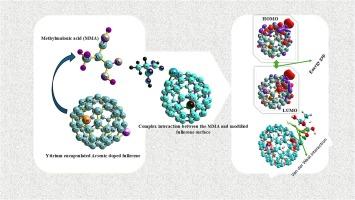Yttrium-encapsulated fullerene (Y@C80) mono-doping with As, Bi, Sb, and P for the enhanced sensing of methylmalonic acid (MMA) as a biomarker for vitamin B12 deficiency: A DFT study
IF 3
3区 化学
Q3 CHEMISTRY, PHYSICAL
引用次数: 0
Abstract
The development of new approaches or approaches for the detection of methylmalonic acid from biological samples is now necessary for early diagnosis of vitamin B12 deficiency and appropriate treatment. In this study, Yttrium-encapsulated fullerene (Y@C80) doped with arsenic (As), bismuth (Bi), phosphorous (P), and antimony (Sb) was investigated for its ability to sense methylmalonic acid (MMA) as a biomarker using M06-2X/GenECP/def2svp/LanL2DZ method. The nanostructural analysis showed a marginal deviation in the bond lengths between atoms of the structure upon optimization of the structures interacting with the MMA biomarker, which demonstrated the stability of the system for sensing. The HOMO-LUMO reactivity descriptor revealed that the compound was reactive toward the sensing of the MMA biomarker, as the various systems MMA_As_Y@C80, MMA_Bi_Y@C80, MMA_P_Y@C80, and MMA_Sb_Y@C80 demonstrated relatively short energy gaps of 2.039 eV, 2.025 eV, 2.135 eV, and 2.023 eV, respectively. The nanomaterial strongly adsorbed the biomarker, as indicated by the negative adsorption energies of −0.47075 eV, −0.70478 eV, 0.9034 eV, and −0.5388 eV corresponding to MMA_As_Y@C80, MMA_Bi_Y@C80, MMA_P_Y@C80, and MMA_Sb_Y@C80, respectively; however, MMA-P-Y@C80 showed a weaker ability to sense the biomarker. Additionally, the recovery time after the detection of the biomarker was relatively short, comparable to the increase in the adsorption strength, with MMA-Bi-Y@C80 having the shortest recovery time (3.829 × 10−37). This is significant for the development of a highly sensitive and efficient technique for methylmalonic acid (MMA) biomarker sensing.

用 As、Bi、Sb 和 P 单掺杂钇包封富勒烯 (Y@C80),增强甲基丙二酸 (MMA) 的传感,作为维生素 B12 缺乏症的生物标志物:DFT 研究
目前,有必要开发从生物样本中检测甲基丙二酸的新方法或新途径,以便及早诊断维生素 B12 缺乏症并进行适当治疗。本研究采用 M06-2X/GenECP/def2svp/LanL2DZ 方法,研究了掺杂砷(As)、铋(Bi)、磷(P)和锑(Sb)的钇包封富勒烯(Y@C80)感知甲基丙二酸(MMA)作为生物标志物的能力。纳米结构分析表明,在优化与 MMA 生物标记物相互作用的结构后,结构原子间的键长略有偏差,这表明该系统具有稳定的传感能力。HOMO-LUMO 反应性描述符显示,该化合物对 MMA 生物标记物的传感具有反应性,因为各种体系 MMA_As_Y@C80、MMA_Bi_Y@C80、MMA_P_Y@C80 和 MMA_Sb_Y@C80 的能隙相对较短,分别为 2.039 eV、2.025 eV、2.135 eV 和 2.023 eV。MMA_As_Y@C80、MMA_Bi_Y@C80、MMA_P_Y@C80 和 MMA_Sb_Y@C80 的负吸附能分别为 -0.47075 eV、-0.70478 eV、0.9034 eV 和 -0.5388 eV,表明纳米材料对生物标记物有很强的吸附能力;但 MMA-P-Y@C80 对生物标记物的感应能力较弱。此外,生物标记物检测后的恢复时间相对较短,与吸附强度的增加相当,其中 MMA-Bi-Y@C80 的恢复时间最短(3.829 × 10-37)。这对于开发一种高灵敏度、高效率的甲基丙二酸(MMA)生物标记物传感技术具有重要意义。
本文章由计算机程序翻译,如有差异,请以英文原文为准。
求助全文
约1分钟内获得全文
求助全文
来源期刊

Computational and Theoretical Chemistry
CHEMISTRY, PHYSICAL-
CiteScore
4.20
自引率
10.70%
发文量
331
审稿时长
31 days
期刊介绍:
Computational and Theoretical Chemistry publishes high quality, original reports of significance in computational and theoretical chemistry including those that deal with problems of structure, properties, energetics, weak interactions, reaction mechanisms, catalysis, and reaction rates involving atoms, molecules, clusters, surfaces, and bulk matter.
 求助内容:
求助内容: 应助结果提醒方式:
应助结果提醒方式:


